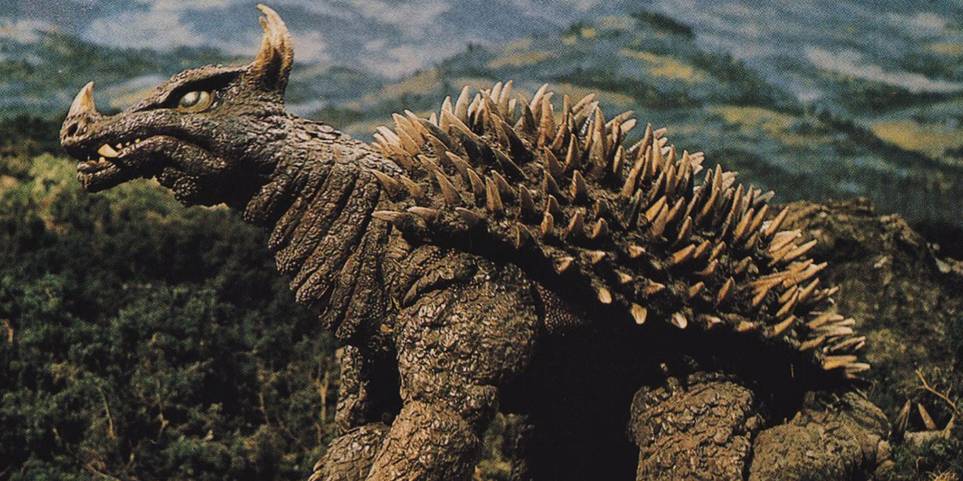
BIO:
At the start of the Paleogene era, resources were scarce so the herbivorous Polacanthus evolved into the omnivorous Angilasaurus. To accommodate its new diet, Angilasaurus grew sharp teeth in order to tear and break down flesh and bone. Its carapace also became more flexible, allowing Angilasaurus to roll up into a defensive ball for protection and to move around. After generations of taking on this defensive stance, the original spikes on its back smoothed out and shortened to accommodate its new way of maneuvering around its environment.
The tail also lost a considerable amount of osteoderms, adding to its flexibility when in the ball pose. Even with these changes, Angilasaurus’ tail remained a formidable defense against predators. The remaining osteoderms on the tail became light weight and thagomizer-like, creating the perfect weapon for close combat.
Fossil evidence shows that Angilasaurus rivaled Gojirasaurus throughout their history. Although they were the rulers of Europe in their heyday, they were periodically threatened by the amphibious rulers of the time. Paleontologists believe this eons long rivalry was the catalyst for Angilasaurus evolving its flexible carapace to avoid potentially being flipped over by Gojirasaurus.
In the Neogene era, Angilasaurus evolved into Anguirus with new traits such as a diamond-hard but flexible carapace. Like its distant relatives the Ankylosaurids, Anguirus went through convergent evolution to form a club that offered protection against potential predators like Godzilla. The adults have spiked clubs that can penetrate Godzilla’s hide and also launch regenerable barbs.
Used as a last resort, Anguirus has the ability to open up the carapace and inhale more air into the lungs for a sonic roar attack. Anguirus’ sonic roar and remarkable endurance in combat comes from its giant lungs used to wear down prey and enemies in drawn out slug matches. Unfortunately all but one of the species perished thousands of years ago in what some paleontologists hypothesize to be some form of severe thunderstorms. Regardless, in the modern day, the tenacious Anguirus is recognized as the “Armored Brute”.
Spanish: Biografía de Anguirus
Al principio de la era Paleógena, los recursos eran escasos, por lo que
el Polacanthus herbívoro evolucionó al Angilasaurus omnívoro. Para
adaptarse a su nueva dieta, el Angilasaurus desarrolló dientes afilados
para desgarrar carne y quebrar huesos. Su caparazón también se hizo más
flexible, lo que permitió al Angilasaurus enrollarse en una bola
defensiva para protegerse y desplazarse. Tras generaciones de adoptar
esta postura defensiva, las púas originales de su espalda se suavizaron y
acortaron para adaptarse a su nueva forma de maniobrar en su medio
ambiente.
La cola también ha perdido una cantidad considerable de
osteodermos, lo que aumenta su flexibilidad cuando adopta la postura de
bola. Incluso con estos cambios, la cola del Angilasaurus seguía siendo
una formidable defensa contra los depredadores. Los osteodermos que
quedaban en la cola se volvieron ligeros y con forma de thagomizer,
creando el arma perfecta para el combate de cuerpo a cuerpo.
Las pruebas fósiles muestran que el Angilasaurus rivalizó con el
Gojirasaurus a lo largo de su historia. Aunque fueron los gobernantes
de Europa en su época de esplendor, periódicamente se veían amenazados
por los gobernantes anfibios de la época. Los paleontólogos creen que
esta rivalidad de siglos fue el catalizador para que el Angilasaurus
evolucionara su caparazón flexible para evitar ser potencialmente
volteado por el Gojirasaurus.
En el Neógeno, el Angilasaurus evolucionó hasta convertirse en
Anguirus, con nuevos rasgos como un caparazón duro como el diamante pero
flexible. Al igual que sus parientes lejanos los Anquilosaurios,
Anguirus pasó por una evolución convergente para formar un garrote que
ofrecía protección contra posibles depredadores como Godzilla. Los
adultos tienen garrotes con púas que pueden penetrar la piel de Godzilla
y también lanzan púas regenerables.
Utilizado como último recurso, Anguirus tiene la capacidad de
abrir el caparazón e inhalar más aire en los pulmones para un ataque de
rugido sónico. El rugido sónico de Anguirus y su notable resistencia en
combate se deben a sus gigantescos pulmones, que utilizan para desgastar
a sus presas y enemigos en prolongados combates. Desgraciadamente,
todas las especies, excepto una, perecieron hace miles de años en lo que
algunos paleontólogos suponen que fue alguna forma de tormentas
eléctricas muy severas. Independientemente de eso, en la actualidad, el
tenaz Anguirus es reconocido como el "Bruto Armado".
Japanese:
アンギラス伝記:
古第三紀初期、資源が乏しく、草食のポラカンサスは雑食のアンジラサウルスに進化した。アンギラサウルスは新しい食事に対応するため、肉や骨を引き裂き分解するための鋭い歯を生やすようになった。また、甲羅はより柔軟になり、アンジラサウルスは身を守るため、丸まって移動することができるようになった。何世代にもわたってこのような防御体制をとり続けた結果、背中のトゲは滑らかになり、短くなり、新しい環境に適応するようになった。
また、尻尾は骨芽細胞を著しく失い、体を丸めて防御姿勢をとった時の柔軟性が高まった。このような変化があっても、アンジラサウルスの尾は捕食者に対する強力な防御手段であることに変わりはなかった。尾に残った骨芽細胞は軽量化され、タゴマイザーのようになり、近距離での戦闘に最適な武器となったのである。
アンジラサウルスは、その歴史を通じてゴジラサウルスに匹敵する存在であったことが、化石から明らかになっている。全盛期にはヨーロッパの支配者であったが、当時の水陸両用の支配者に定期的に脅かされていたのである。この幾年にもわたるライバル関係がきっかけとなって、アンジラサウルスがゴジラサウルスにひっくり返される可能性を避けるために、柔軟な甲羅を進化させたと、古生物学者は考えている。
新第三紀には、アンギラサウルスはダイヤモンドのように硬くも柔軟な甲羅を持つアンギラスに進化した。アンギラスは、遠縁のアンキロサウルス類と同様に収斂進化を経て、ゴジラのような脅威となる捕食者から身を守るための棍棒を形成するようになった。成体のアンギラスは、ゴジラの皮膚を貫通できるトゲのある棍棒を持ち、再生可能なトゲを放つこともできた。
最後の手段として、甲羅を開いて肺に空気を取り込み、ソニックローア攻撃を行うことができる。アンギラスのソニックローア攻撃と戦闘における驚異的な耐久性は、獲物や敵を消耗させ長時間にわたる戦闘を行うために使用される、その巨大な肺に由来する。残念ながら、古生物学者によると、一種を除くすべての種が数千年前に激しい雷雨のようなもので滅んでしまったそうだ。しかし、現代では、この粘り強いアンギラスは、「アーマード・ブルート 」として認識されている。
No comments:
Post a Comment